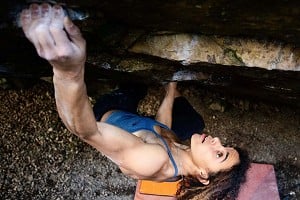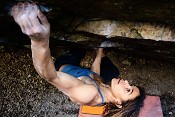
Climber and physiotherapist Andrew McVittie shares some tips to keep your fingers healthy...
As climbers we ask an awful lot of our fingers. They are compressed, stretched, twisted, jammed into cracks and subjected to all sorts of forces. It is a testament to the amazing ability of the body to adapt that they can do all of these. But it is also no surprise that fingers are commonly injured, accounting for around 40% of all climbing related injuries.
Injuries are so multi-factoral we can only talk about injury reduction, not prevention. A semantic point perhaps, but an important distinction. We cannot stop all injuries. When we do avoid an injury we don't even know that we did. So, it feels like work put in that never shows a result. This is why a lot of us don't do this type of intervention.
This article does not promise to dramatically reduce overuse or acute finger injuries. I feel I may have just lost 50% of readers… That is achieved by building robust fingers over time. There is no magic bullet. But we will explore how common issues occur, assess some of things we often do in the name of finger care and show what we know can help the long-term health of our fingers.
But first a bit of anatomy and terminology:
Anatomy of the hand joints
Crimp forces – cartilage in green
Taking a hold with a 90-degree, or more, bend in the Proximal Interphalangeal joint (PIP) causes compressive forces in the Distal Interphalangeal joint (DIP) and the PIP.
Expansive forces in an open hand grip
If you take a hold with an open grip, the forces are expansive. The soft tissues of the joints must resist being pulled apart.
Compressive forces are borne by the cartilage and synovial fluid. Synovial fluid is amazing stuff. It's a shock absorber, lubricating oil and provider of nutrients to the cartilage. This is particularly important as finger cartilage has very poor blood flow.
The capsule of the finger joints is like a thick, ligamentous sock that surrounds the joint. Its inner membrane (the synovium) produces the synovial fluid.
Ligaments, such as the lateral collateral ligaments, blend into the capsule (see first pic). It has a joint-supporting role and needs to be robust enough to deal with twisting, compressive and expansive forces.
The capsule is slightly porous. When pressure increases fluid is forced out. When it decreases fluid is encouraged in. This is an essential part of maintaining a healthy joint. Waste products and inflammatory factors are flushed out and nutrient rich plasma taken in to provide nutrients the cartilage needs to remain healthy.
The process of pushing the fluid out is active. The replenishment is passive. It takes longer to refill the tank than it does to empty it. If this process is repeated it is easy to see how a finger joint can finish a session with depleted synovial fluid. This depletion can trigger an inflammatory response, which we will look at shortly.
Synovial fluid is a thixotropic non-Newtonian fluid. It changes its characteristics in relation to forces applied to it. Higher forces induce a thinning response. This allows more fluid to flow out of the joint and then when we return to rest the fluid thickens, but is now outside of the capsule and can't get back in.
We need mechanical stress and joint pressure changes, but too much is going to leave us with inflamed, stiff, joints.
We will now look at how over-training/under-resting can cause joint issues, such as synovitis (inappropriate growth of the synovial lining), capsulitis (inflammation of the ligaments surrounding the joint), stiffness and reduced range.
A synovial joint
Synovitis is an inflammation and/or growth of the synovial membrane that covers the inside of the joint capsule. The synovial membrane produces synovial fluid. The process can be triggered by an acute inflammation within the joint that then irritates the membrane, or from repeated active compressive forces, such as in crimping.
This could be from repeated compressive forces to one area of cartilage (beyond what it can currently deal with) and/or the depletion of the synovial fluid during a session. This inflammation results in increased synovial fluid production as it irritates the membrane.
If the joint experiences increases in repeated, compressive, forces it adapts. Part of that adaptation is to increase the thickness of the joint capsule. As the synovial membrane is part of the capsule it also thickens. It is now bigger and can produce more synovial fluid.
These increases in synovial fluid (from differing or combined processes) increase the pressure inside the capsule. The body responds to this by, you guessed it, thickening the joint capsule. This can become a bit of a vicious circle, where the joint has inflammation and hypertrophy occurring simultaneously. If the mechanical stimulation is still present (crimping) it can be very difficult to stop.
Capsulitis stems from repeated load and stress of the supportive ligaments of the fingers – passive tension as you hang from them rather than being active, like in open-hand hanging.
The body is fantastic at adapting to increased loads, but too much, too soon, repeated too often, will compromise joint health. This is why finger training should be consistent, but varied and gradual in its progression.
Accessory movements
Accessory movements are movements our joints are designed to perform, but we are not able to control consciously. Jam them in a crack and hang off them and see how much they twist. Now try and rotate or twist your fingers like that while they are not touching anything. You can't, but they are meant to have that range.
This principle applies in all our joints of similar construction. It allows the load to be spread to different areas of cartilage, as well as allowing our joints to get into biomechanically better positions.
It also lets us put them into positions they are not ready for, yet. But they can be adapted to tolerate the weird and wonderful positions we demand of them, if we go slow and use variety in the stimulation we give them.
Take a look at your fingers the next time you crimp on a fingerboard or rung, especially with your little finger on.
The divergence of the red lines from the straight green lines shows how the fingers can bend and twist when crimping. This is affected by individual finger lengths, especially comparatively short little fingers. I have also seen (more rarely) rolling towards the thumb which loads the first two fingers very heavily.
The synovitis scenario described above was initially triggered by one area of the cartilage becoming irritated due to repeated loading.
If we repeatedly load fingers the same way, on a finger board for example, the same area of cartilage gets repeatedly loaded, compressed, and stressed. They then get irritated and, if not given enough time to recover, the cartilage can degrade over time. This repetition can also apply on a board or a climbing wall, where we often push all four of our fingertips to the back of the hold, to get as much contact as we can.
This doesn't mean that walls, boards and fingerboards are bad. Just that we need to be aware of their repetitive nature. It is this controlled repetition that stimulates the adaptations we want. But too much of anything is not good for us, even if it is necessary in smaller doses, like fingerboarding.
Stiffening
Joints also adapt by increasing stiffness in line with the forces they are experiencing.
Research has shown climbing stimulates adaptive changes through thickening in the volar plates, flexor tendons, ligaments and joint capsule. This makes the joint stiffer and stronger. A sensible course of action for the body to take. Not so sensible when we consider it means the ability of the joint to spread the load over different areas of cartilage is now compromised. The range of accessory movements has been reduced.
Long-term issues, such as osteo-arthritis are hugely multi-factoral, complex, and still poorly understood. I cannot definitively say that compromise of the cartilage will lead to symptomatic osteo-arthritis over time. But I do feel able to say that taking action to ensure you spread the load on your cartilage will certainly not do any harm.
Load Management
The best thing you can do to reduce your chances of injury and longer-term issues is to manage your overall finger load with variety and control and maintain accessory movement ranges.
Load spikes are by far and away the biggest risk factor. If you start something new like fingerboarding, board climbing, or increase your volume, then do it SLOWLY.
We all kind of know that already, but I won't apologise for repeating it as we often don't do it.
The interventions that follow are not a replacement for variety and load management, but a supplement to them.
Interventions
There are lots of things to choose from and I have grouped a few here to quickly summarise them:
- Finger massage rings
- Soft tissue release
- Fascial release
- Scraping
- Cupping
- K-taping
You may guess that I have grouped them together for a reason. They don't work. Or at least they don't do what you think they do. They can all make you feel good. That can be very worthwhile, as long as we're not fooling ourselves that it is reducing, preventing or healing injury.
Interventions that do improve tissue health and joint ranges
Regeneration hangs/minimums
These are used to stimulate the soft tissue of the fingers, and wrists, elbows and shoulder. They also provide a signal to the synovial fluid to become more fluid and less stiff. So they can be good to do at the end of a high intensity climbing session, or the morning after if you have stiff fingers.
Think of it as being like a recovery jog for your upper limbs. It gets them active, the blood circulating, transports waste materials away, while bringing in nutritional factors for tissue health.
You will likely need to have your feet on the floor, as you need to be operating at around 30-60% body weight, for short bursts. Don't try and dangle around on a pulley with 50kgs hanging off you. You don't need to be that accurate. You can do this on a fingerboard, circuit board or an actual board.
The issue with a circuit board is that the holds would likely have to be so big that they would be jugs and then you are not targeting the fingers so much.
You can put your feet on the floor at the base of the board then use the more fingery holds. Lean back and walk around the board with your hands, moving your feet as needed. Just do 10 moves or so. Rest a minute and repeat 5 times.
When using a finger board to do minimums I take the opportunity to load the fingers in unusual positions. I also do this if doing any kind of low-level fingerboard work. So often when we train our fingers are in the same position, on the same holds, and working together as a unit of 2, 3 or 4.
These complex positions encourage them into positions requiring accessory movements and use of the intrinsic muscles of the hands. We use the same protocol of being active for around 10-15 seconds then resting for around a minute, 5 times.
Finger joint care routine
One minute rest times are really annoying. Not long enough to check Insta, have a stretch or do another exercise. But long enough that standing there staring into space gets a bit boring.
So do these:
Joint distractions
Essentially we are going to pull the finger so the space between the bones increases, only slightly, don't worry, and the connective tissues are stretched. This is thought to reduce the pressure within the capsule and aids the process of synovial fluid refill. I'm sure it does a bit, but I don't think it's refilling the tank super quick. So don't just do this and feel you've done all you need to do. Adequate rest between sessions is the key here. But I do think these stretches help reduce ligament/capsule stiffness induced by the repetitive nature of climbing/training.
People often feel concerned about pulling their fingers apart firmly. Think about how hard you pull on them when climbing. If your fingers are un-injured you really needn't worry. But build up the pulling effort slowly over a few sessions if you need to.
If you have a finger injury, synovitis, osteo-arthritis and/or unstable finger joints I'd check with a medical professional (who understands climbing) first.
DIP joint
- Keep the hand of the finger to be distracted relaxed
- Take hold of the distal phalanx (end bone) of the finger as shown and pull
- The finger should be firmly clamped between the finger and thumb of the other hand with the point of the thumb pushing into near the joint crease and the end bone at about a 45-degree angle
- Pull for around 30 seconds
PIP joint
- Keep the hand of the finger to be distracted relaxed
- Take hold of the middle phalanx (bone) of the finger as shown and pull
- The finger should be firmly clamped between the finger and thumb of the other hand with the point of the thumb pushing into near the joint crease and the middle bone at about a 90 degree angle
- Pull for around 30 seconds
Accessory movements
- Take hold of the distal phalanx as shown, keep your hand relaxed, twist
- You can fix your hand and twist the finger with your other, or fix the hand that is grabbing and twist from the hand with the finger to be twisted, same result
- Twist for around 15 seconds each way
I often combine the DIP joint distraction with a twist to save time.
So one minute to spend on each finger. You can squeeze them in to the minimum rest times, or do them back home while watching the TV.
Finger care at work (sorry employers!)
When prescribing exercises I always try and remove as many barriers as possible and make them fit into your day. These can easily be done at work.
Extensor stretch
This uses the same hand position as the hook grip. The joint capsules and soft tissues on the back of the hand also become stiffened and sensitised through repetitive, and acute, climbing stresses. The DIP joint is especially susceptible to the tissues being irritated when crimping. This is the opposite of that action and can be quite relieving for DIPs that feel tender.
- Separate your fingers slightly
- Press your hand, palm down, gently onto a firm, but soft, surface
- Mouse mats are ideal for this
- Hold, gently, for 30 seconds
You can also do this on individual fingers by using your other hand to press on the fingernail in the hook grip.
This is entirely anecdotal, and not researched, but I see a lot of younger (sub 30 years) climbers with highly adapted fingers. They have very thick fingers with appearance of Hebden's nodules on the DIP joint. These are recognised as pre-cursors to symptomatic osteo-arthritis. However, I feel in these cases they are bony overgrowth stimulated from repeated climbing stresses. The body has laid down more bone to make the fingers able to handle more forces. They are the first generation who have climbed/trained through their developing years in significant numbers. Time will tell what the long-term implications of these adaptations are.
This thickening of the finger bones, and enlarging of the joints, means the extensor tendons now have to travel further, and the extensor hood can be affected in its movement by the nodules. They are now effectively a bit too short and become tight when you make a fist. The loss of the ability to fully close your hand is not actually very detrimental functionally. But if it can be avoided I feel it should be to potentially stop irritation at the DIP joint.
Pen rolls
This is good for mobilising all joints of the fingers, including the main knuckles (MCP) and increasing blood flow to the muscles of the forearm and hand.
- Hold a pen in your hand like in the picture
- Roll it in your hand with an upward motion
- You may notice your fingers work in pairs – try and work up to using individual fingers
Wrist stretches
- These are the standard wrist stretches we have all seen before – follow the pictures
- You can do them on your desk rather than the floor
- Gentle stretching after climbing, or at work, for 30 seconds
How do I know when my fingers are recovered enough for another session?
There is no definitive answer to this I am afraid.
Feelings of tiredness and fatigue are what we often feel we should be chasing in training. This can have its place with muscles, but with connective tissue and joints this is not what we are looking for. There are no muscles in your fingers. So, if they feel swollen, stiff or sore this is a sign to consider what you are doing.
Hook grip
A nice, quick test can be to curl your fingers into a hook grip and see how close you can get your fingers to your palm. Do this when your fingers feel good and then you have a benchmark to compare with. If when you bend them they feel swollen and puffy, or tight on the side of the knuckles, these are all signs that you may need more recovery time or to change your session. You also need to consider whether what you just did with them was appropriate.
In summary – climbing is very hard on our fingers. The best thing you can do to reduce injury is to be careful with increasing loads in any form, avoid spikes, and gradually build robust fingers over time.
Build in a little finger care at the end of every climbing session to reduce joint stiffness and do the mobility work of the hands and wrists during the day, or when you do other stretching work.


































Comments
The tip about minimals and the one about the hook grip to test recovery - brilliant! I'll definitely (try to remember to!) use those!!
Thanks!
I'm glad you found it useful.
Excellent article, thank you. Some very useful exercises that my partner and I intend building into our post climb routines. Given the amount of time we spend hammering our fingers at walls or bouldering during the winter, its vrry timely too. Nice one
Excellent.
It's too late for me, I fear, but I shall forward the article to nieces and nephews who've just started climbing.
I was struck by the paragraph that said we're now seeing the first generation of climbers who spent their growth years climbing hard in the gym, have continued to climb hard and we're yet to see how this will play out in late-middle age and old age...
Anyway, great article - I'll be putting a lot of the exercises mentioned to the test.
j
Thanks Ben. Let me know how you find them and if you keep them up.